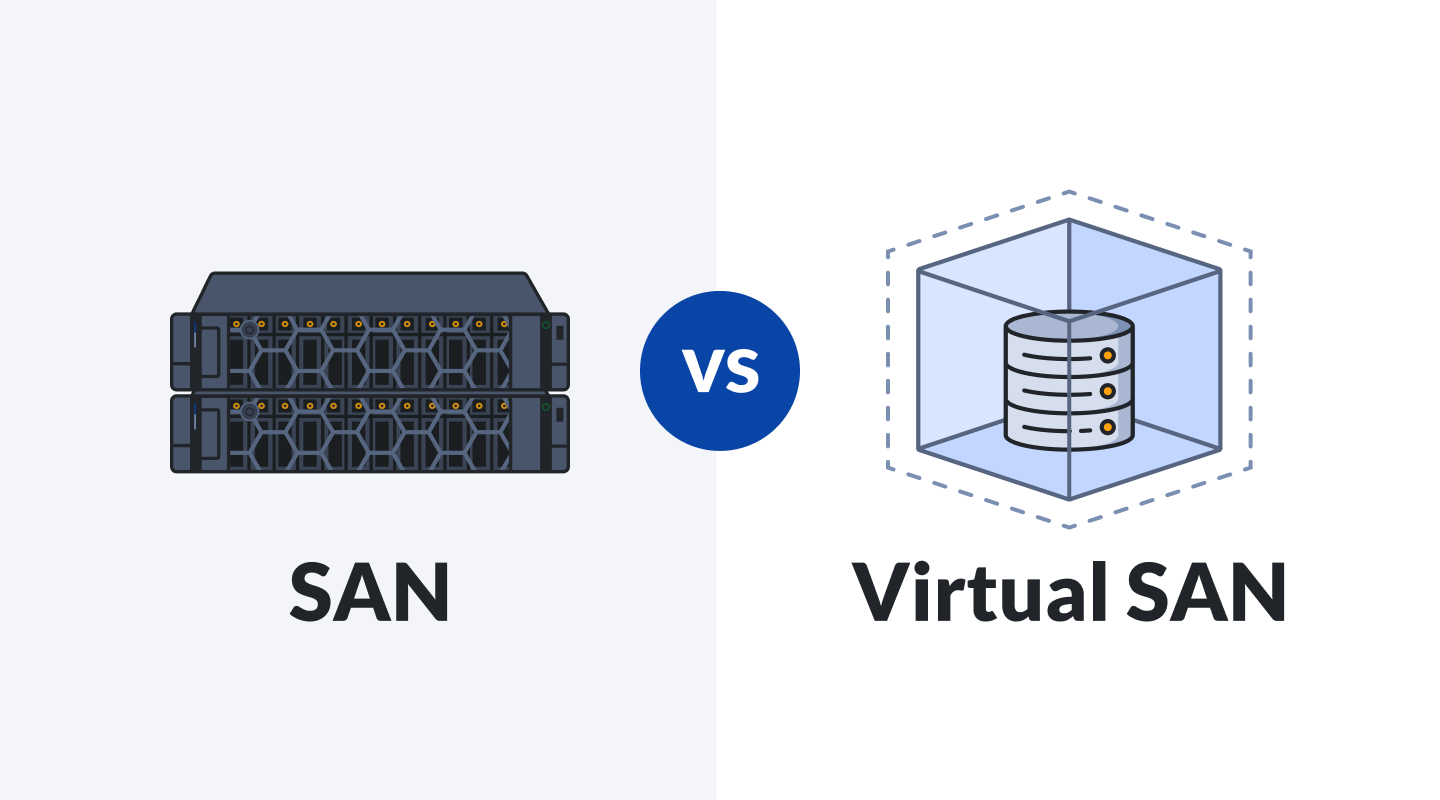In our fast-changing digital world, storage solutions are vital to keep businesses running smoothly and their essential apps and services working without any hiccups. Two prominent players in the realm of storage are a traditional Storage Area Network (SAN) and its virtual counterpart – virtual SAN. These solutions serve as the backbone for storing, managing, and accessing data, yet they differ in their approaches and capabilities. This article delves into the nuances of virtual SAN and traditional SAN systems, their key features, and a comparative analysis to help you make an informed decision about your storage infrastructure.

What is Virtual SAN (VSAN)?
Virtual Storage Area Network (VSAN) is a software-defined storage solution that, using protocols like iSCSI or Fibre Channel, creates a virtualized pool of storage resources from multiple physical storage devices, such as hard drives or solid-state drives. In this way, the latter become available to virtual machines (VMs) and applications in a data center or cloud environment. This virtualized storage can be dynamically allocated and managed to meet the storage needs of different VMs and applications. In essence, virtual SAN serves as a virtual storage appliance that can be seamlessly integrated with popular hypervisors such as VMware vSphere, Microsoft Hyper-V, KVM, or Citrix (formerly XenServer). This integration allows organizations to establish block-mode storage solutions optimized for structured data. Unlike traditional SAN, which often comprises a complex web of distinct hardware components, VSAN offers a more streamlined approach by being deployable on industry-standard x86 servers, provided they run a compatible virtualized host environment.
By using software-defined storage techniques, VSAN abstracts and virtualizes physical storage, offering greater flexibility and efficiency in storage management. It is often used to enhance data storage and management in virtualized and hyperconverged infrastructure environments.
What is Traditional SAN?
Traditional Storage Area Networks, often referred to as SAN, have been a staple in the world of data storage for many years. SAN operates as a dedicated network that connects storage devices to servers, offering centralized storage management and data access. In a SAN setup, storage devices are typically separate from the servers and are accessed through specialized hardware.
SANs have traditionally been known for their reliability, performance, and suitability for mission-critical applications. However, they can also be complex to manage and expensive to implement due to the need for specialized hardware components.
Key Features of VSAN
- Reduced Data Latency: VSAN eliminates the need for external networked storage, reducing data latency and ensuring faster response times. This is especially important for applications demanding low-latency access to data.
- Enhanced Data Protection: With its distributed architecture, VSAN provides robust data protection, automatically replicating data to other servers. This protection extends to safeguarding against server failures, ensuring data integrity and availability.
- Simplified Storage Management: VSAN offers centralized management, streamlining storage resource management and health monitoring. This ease of management translates to increased efficiency and reduced room for error in provisioning and maintenance.
- Integration with Containers and Virtual Machines: VSAN seamlessly integrates with virtualization technologies, including containers and VMs. This versatility allows organizations to run both traditional and modern applications on the same storage infrastructure, enhancing flexibility and adaptability.
- Cost-Efficiency: VSAN’s ability to pool existing server local storage and flash components into a virtualized pool leads to cost savings. This cost-effectiveness makes it an attractive option for organizations seeking efficient storage solutions without breaking the budget.
Key Features of SAN
- High Performance: Traditional SANs excel in providing high-speed data access and low latency, making them suitable for performance-critical applications. They are often chosen for their reliability and consistency.
- Data Protection: SANs are known for their robust data protection features, including RAID configurations and failover capabilities. These features ensure data integrity and minimize downtime in the event of hardware failures.
- Deployment for Structured Workloads: SANs are ideal for handling structured data workloads, making them suitable for environments with demanding data processing requirements.
- Support for Critical Workloads: Traditional SANs can handle mission-critical workloads effectively, ensuring uninterrupted operations even in high-stakes scenarios.
- Enterprise-Grade Features: SANs often come equipped with enterprise-grade features, making them well-suited for large organizations with complex storage needs. These features may include advanced security, scalability, and comprehensive management tools.
VSAN vs SAN: A Comparative Analysis
Now, let’s delve into a comparative analysis to understand the core differentiators between VSAN and SAN, shedding light on how these storage solutions impact on efficiency, performance, and the bottom line of organizations.
| VSAN | SAN | |
| Deployment and Infrastructure |
A software-defined storage solution that operates on industry-standard x86 servers Does not rely on external networked storage, reducing complexity and the need for specialized hardware |
Consists of physical appliances networked together to handle block-level data Often requires a dedicated infrastructure, including Fibre Channel switches and storage arrays, making them more hardware dependent |
| Latency and Responsiveness | Eliminates the need for external storage, and, depending on implementation and used protocol, may minimize data latency, resulting in faster response times. This is critical for applications requiring low-latency access to data. | Can offer high performance and low latency, but the reliance on external storage and additional network layers can introduce additional latency compared to some VSAN implementations (for example, with NVMe-oF protocol) |
| Scalability | Allows for seamless scalability by adding more servers to the cluster, making it suitable for organizations with evolving storage needs | May face scalability limitations due to hardware constraints, potentially requiring costly upgrades or replacements |
| Data Protection and Availability | Designed with data protection in mind, automatically replicating data to other servers. This distributed architecture ensures data availability, even in the event of server failures.
|
Offers data protection features but may require manual intervention and configuration to ensure high availability
|
| Management and Cost | Provides centralized management, simplifying storage resource management and monitoring. Its cost-efficiency stems from the ability to leverage existing server local storage and flash components. | Can be expensive to implement and maintain, requiring a team of experts for hardware management and monitoring |
The choice between VSAN and SAN should align with your organization’s specific requirements and priorities. VSAN offers simplicity, scalability, and cost-effectiveness, making it an attractive choice for modern data-driven environments. In contrast to traditional SANs, which segregate storage into separate hardware components, VSAN adopts a distinct approach. It enables administrators to distribute storage across servers and consolidate these resources logically. On the other hand, SAN excels in high-performance scenarios and may be preferred for mission-critical workloads. The decision ultimately hinges on your organization’s unique needs and long-term storage strategy.
Why choose StarWind Virtual SAN?
Selecting the right Virtual SAN (VSAN) solution for your enterprise can be a daunting task, but StarWind Virtual SAN (VSAN) stands out as a top choice, catering to the specific needs of Enterprise ROBO, SMBs, and Edge environments. In contrast to traditional SAN solutions that rely on complex hardware configurations, StarWind Virtual SAN takes a “software replaces hardware” approach, making it an integral part of the hyperconverged infrastructure (HCI).
StarWind Virtual SAN revolutionizes storage by combining flash and disk resources within a cluster to create a virtual shared storage pool accessible to all hosts. This innovative approach significantly reduces the cost and complexity associated with virtualization, eliminating the need for physical shared storage like SAN, NAS, and DAS. The result is a streamlined and cost-effective solution, making it an ideal choice for organizations facing budget constraints and resource limitations, such as SMBs. With a proven track record of serving customers since 2009, StarWind’s Virtual SAN product has gained the trust of over 63,800 businesses.
Conclusion
In the ongoing debate of VSAN vs. SAN, it’s essential to recognize that both have their merits and can address diverse storage requirements. The decision ultimately depends on factors such as budget, scalability needs, performance demands, complexity of infrastructure, and the extent to which your organization values flexibility and simplicity in storage management. As the digital landscape evolves, making an informed choice between VSAN and SAN becomes increasingly crucial for staying competitive and efficient in today’s data-driven world.
This material has been prepared in collaboration with Iryna Chaplya, Technical Writer at StarWind.



